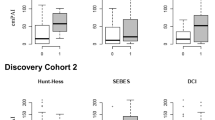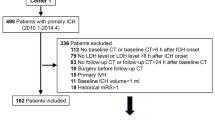Abstract
Therapeutic hypothermia (TH) is a neuroprotective treatment post-cardiac arrest but is grossly underutilized. After TH induction, traditional biomarkers and parameters can no long predict clinical outcome due to a lack of understanding of hypothermic response. Innovative approaches to better understand the clinical effect of TH will help to prognosticate outcome and expand beneficial population. Protein glycosylation is an important extracellular post-translational modification, regulating various extracellular signaling pathways. Here, we used glycoproteomics to investigate the association of plasma glycoproteins with the prognosis of TH-treated cardiac arrest patients. Using lectin affinity chromatography and mass spectrometry, we identified 640 glycoproteins in the plasma of cardiac arrest patients undergoing TH treatment, of which 23 were up-regulated and 14 were down-regulated in good outcome patients as compared with poor outcome ones. Notably, two glycoproteins with antioxidant activity, ceruloplasmin (CP) and haptoglobin (HP), were found to be associated with favorable neurologic outcome. This was further supported by ELISA assay in a large patients cohort, in which glycosylated CP and HP enriched by concanavilin A (ConA) and wheat germ agglutinin (WGA) lectins were significantly increased in patients developing good outcome (ConA-CP: p = 0.033; ConA-HP: p = 0.04; WGA-HP: p = 0.021). Furthermore, ROC analysis demonstrated the predictive potential of ConA-CP, ConA-HP, and WGA-HP (ConA-CP: AUC = 0.732, p = 0.031; ConA-HP: AUC = 0.746, p = 0.022; WGA-HP: AUC = 0.714, p = 0.046) and combination of them improved the predictive power (AUC = 0.830, p = 0.002). Our results suggested that glycosylated CP and HP as well as other glycoproteins may play critical roles in neuroprotection and serve as sensitive prognostic markers for TH treatments.



Similar content being viewed by others
References
Bernard SA, Gray TW, Buist MD, Jones BM, Silvester W, Gutteridge G, et al. Treatment of comatose survivors of out-of-hospital cardiac arrest with induced hypothermia. N Engl J Med. 2002;346(8):557–63. doi:10.1056/NEJMoa003289.
Hypothermia after Cardiac Arrest Study G. Mild therapeutic hypothermia to improve the neurologic outcome after cardiac arrest. N Engl J Med. 2002;346(8):549–56. doi:10.1056/NEJMoa012689.
Nolan JP, Morley PT, Vanden Hoek TL, Hickey RW, Kloeck WG, Billi J, et al. Therapeutic hypothermia after cardiac arrest: an advisory statement by the advanced life support task force of the International Liaison Committee on Resuscitation. Circulation. 2003;108(1):118–21. doi:10.1161/01.CIR.0000079019.02601.90.
Al Thenayan E, Savard M, Sharpe M, Norton L, Young B. Predictors of poor neurologic outcome after induced mild hypothermia following cardiac arrest. Neurology. 2008;71(19):1535–7. doi:10.1212/01.wnl.0000334205.81148.31.
Mortberg E, Zetterberg H, Nordmark J, Blennow K, Rosengren L, Rubertsson S. S-100B is superior to NSE, BDNF and GFAP in predicting outcome of resuscitation from cardiac arrest with hypothermia treatment. Resuscitation. 2011;82(1):26–31. doi:10.1016/j.resuscitation.2010.10.011.
Clerc F, Reiding KR, Jansen BC, Kammeijer GS, Bondt A, Wuhrer M. Human plasma protein N-glycosylation. Glycoconj J. 2016;33(3):309–43. doi:10.1007/s10719-015-9626-2.
Hansson K, Stenflo J. Post-translational modifications in proteins involved in blood coagulation. J Thromb Haemost. 2005;3(12):2633–48. doi:10.1111/j.1538-7836.2005.01478.x.
Maverakis E, Kim K, Shimoda M, Gershwin ME, Patel F, Wilken R, et al. Glycans in the immune system and the altered glycan theory of autoimmunity: a critical review. J Autoimmun. 2015;57:1–13. doi:10.1016/j.jaut.2014.12.002.
Sharon N. Lectins: past, present and future. Biochem Soc Trans. 2008;36(Pt 6):1457–60.
Butterfield DA, Owen JB. Lectin-affinity chromatography brain glycoproteomics and Alzheimer disease: insights into protein alterations consistent with the pathology and progression of this dementing disorder. Proteomics Clin Appl. 2011;5(1–2):50–6. doi:10.1002/prca.201000070.
Wang Y, Ao X, Vuong H, Konanur M, Miller FR, Goodison S, et al. Membrane glycoproteins associated with breast tumor cell progression identified by a lectin affinity approach. J Proteome Res. 2008;7(10):4313–25.
Deng WJ, Nie S, Dai J, Wu JR, Zeng R. Proteome, phosphoproteome, and hydroxyproteome of liver mitochondria in diabetic rats at early pathogenic stages. Mol Cell Proteomics. 2010;9(1):100–16. doi:10.1074/mcp.M900020-MCP200.
Pencina MJ, D'Agostino RB. Overall C as a measure of discrimination in survival analysis: model specific population value and confidence interval estimation. Stat Med. 2004;23(13):2109–23. doi:10.1002/sim.1802.
Huang da W, Sherman BT, Lempicki RA. Systematic and integrative analysis of large gene lists using DAVID bioinformatics resources. Nat Protoc. 2009;4(1):44–57. doi:10.1038/nprot.2008.211.
Burkitt MJ. A critical overview of the chemistry of copper-dependent low density lipoprotein oxidation: roles of lipid hydroperoxides, alpha-tocopherol, thiols, and ceruloplasmin. Arch Biochem Biophys. 2001;394(1):117–35. doi:10.1006/abbi.2001.2509.
Van Vlierberghe H, Langlois M, Delanghe J. Haptoglobin polymorphisms and iron homeostasis in health and in disease. Clin Chim Acta. 2004;345(1–2):35–42. doi:10.1016/j.cccn.2004.03.016.
Polderman KH. Mechanisms of action, physiological effects, and complications of hypothermia. Crit Care Med. 2009;37(7 Suppl):S186–202. doi:10.1097/CCM.0b013e3181aa5241.
Tang XN, Yenari MA. Hypothermia as a cytoprotective strategy in ischemic tissue injury. Ageing Res Rev. 2010;9(1):61–8.
Vosler PS, Logue ES, Repine MJ, Callaway CW. Delayed hypothermia preferentially increases expression of brain-derived neurotrophic factor exon III in rat hippocampus after asphyxial cardiac arrest. Brain Res Mol Brain Res. 2005;135(1–2):21–9. doi:10.1016/j.molbrainres.2004.11.006.
Rundgren M, Karlsson T, Nielsen N, Cronberg T, Johnsson P, Friberg H. Neuron specific enolase and S-100B as predictors of outcome after cardiac arrest and induced hypothermia. Resuscitation. 2009;80(7):784–9. doi:10.1016/j.resuscitation.2009.03.025.
Tiainen M, Roine RO, Pettila V, Takkunen O. Serum neuron-specific enolase and S-100B protein in cardiac arrest patients treated with hypothermia. Stroke. 2003;34(12):2881–6. doi:10.1161/01.STR.0000103320.90706.35.
Arumugam TV, Woodruff TM, Lathia JD, Selvaraj PK, Mattson MP, Taylor SM. Neuroprotection in stroke by complement inhibition and immunoglobulin therapy. Neuroscience. 2009;158(3):1074–89. doi:10.1016/j.neuroscience.2008.07.015.
Staikou C, Paraskeva A, Drakos E, Anastassopoulou I, Papaioannou E, Donta I, et al. Impact of graded hypothermia on coagulation and fibrinolysis. J Surg Res. 2011;167(1):125–30. doi:10.1016/j.jss.2009.07.037.
Author information
Authors and Affiliations
Corresponding author
Ethics declarations
Conflict of Interest
The authors declare that they have no conflict of interest.
Human and Animal Rights
All procedures performed in studies involving human participants were in accordance with the ethical standards of the institutional and/or national research committee and with the 1964 Helsinki declaration and its later amendments or comparable ethical standards.
Informed Consent
Informed consent was obtained from all individual participants included in the study.
Funding
This study was funded by the U.S. National Institutes of Health: NS051588 (M.N.) and NS052498 (M.N., E.H.L).
Rights and permissions
About this article
Cite this article
Deng, W., Cao, J., Chen, L. et al. Plasma Glycoproteomic Study of Therapeutic Hypothermia Reveals Novel Markers Predicting Neurologic Outcome Post-cardiac Arrest. Transl. Stroke Res. 9, 64–73 (2018). https://doi.org/10.1007/s12975-017-0558-y
Received:
Revised:
Accepted:
Published:
Issue Date:
DOI: https://doi.org/10.1007/s12975-017-0558-y




